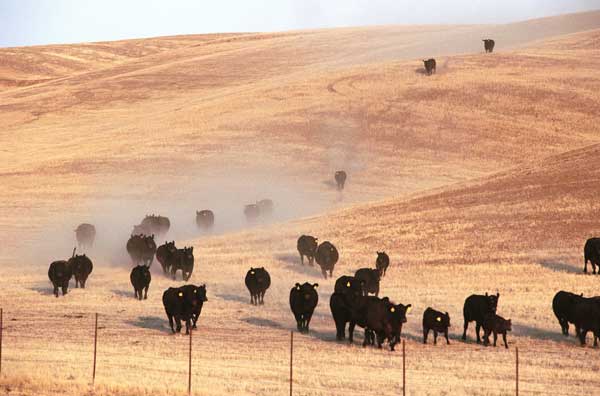
The long road to recovery for Southwest cattle industry
One of the worst droughts on record has forced many livestock producers to cull herds, turn to out-of-state forage sources, and in many cases scramble for adequate water supplies just to keep their herds alive.Early estimates indicate Texas may have lost as much as 20 percent of its beef cattle as a result of last year’s drought.Oklahoma losses could run that high and possibly more counting yearlings and stocker cows.

Historically tough times -- that’s how some livestock experts are summing up the 2011 Southwest livestock industry. One of the worst droughts on record has forced many livestock producers to cull herds, turn to out-of-state forage sources, and in many cases scramble for adequate water supplies just to keep their herds alive.
And in spite of rain in late December and January in Texas, Oklahoma, and New Mexico, the forecast is calling for extended dry conditions and a long road to recovery, even if substantial rainfall comes this summer season.
“The drought is the last in a series of events that have hurt the industry,” says Dr. Derrell Peel, Oklahoma State University Extension Livestock Marketing Specialist. “The timing of the drought couldn’t have been worse. But we didn’t get into this predicament overnight, and we’re not going to get out of it quickly either.”
Peel says he expects recovery to take 4 to 5 years before herds can be significantly reestablished, and says a more patient approach will be necessary before the industry can experience expansion and return to pre-drought conditions. But he says some positive improvement could happen as early as later this year and next year depending on a number of developments, including substantial rainfall.
“It is not just a question of adding back beef cows. There are not enough females to support repopulation in one year. Ranchers won't run out of females, but price will get high enough to encourage producers to wait to buy them. And one of the greatest challenges we face will be redeveloping forage acreage and inventories. This is not going to happen overnight,” he adds. “Producers should consider a more patient recovery strategy of rebuilding cow herds over a two- to four-year period. This may be beneficial to promote optimal recovery and healing of pastures. It also will fit cattle market conditions better.”
Early estimates indicate Texas may have lost as much as 20 percent of its beef cattle as a result of last year’s drought, and Peel says Oklahoma losses could run that high and possibly more counting yearlings and stocker cows.
“As an industry we have painted ourselves into a corner,” says Texas AgriLife Extension agriculture economist Stan Bevers. “We are battered and bruised by a terrible drought and most livestock producers have reacted as you would expect, selling off cows or moving them—often great distances—to greener pastures, and buying out-of-state hay and forage.”
No overnight recovery
Bevers agree that substantial recovery is not going to happen overnight, especially considering assessment of losses is an ongoing process.
“How bad is it? No one knows for certain. We estimate some 120,000 cows won’t be marketed in Texas this year as a result of drought-related problems. Herds were culled, many cows moved out-of-state, including some stocker cattle, and only time will tell how great the impact on the overall industry,” Bevers added.
He says the drought-imposed setback represents a new development in an industry that has been losing ground for some time.
“In 1976 for example, Texas had about 44 million cows. But by 2011 that number had fallen to about 31 million, so the drought accelerated a trend for smaller inventories, and did so at a time when demand was steady and markets were up,” Bevers said.
Both economists say they remain optimistic that the Southwest cattle industry will recover and that patience and innovation will be key for growers to survive. Robust strategies need to be developed and a degree of re-education will be required for the growth of the industry in years to come.
Bevers said this year's drought made it tough to generate profits. However, ranchers have been through droughts before, he says, and the difference now is the additional rising input costs and market volatility. He says coming out of this drought �“will require a new level of understanding and pencil pushing.”
“For a number of years we have been teaching how to grow the industry in a grain-based environment and now we need to learn how to produce cattle that eat less grain. Already we’re seeing a move in that direction,” Peel said.
Alternative feed and forage including by-product feeds like ‘cotton trash’, orange/citrus peel and pulp, corn distiller’s grain, soy hulls, cottonseed and corn stalks are all viable products being tested for cattle feed and may one day replace conventional grains.
“Grain prices aren’t going to get any cheaper and production costs are going to continue to get higher, so in order to survive the industry will need to embrace new ways of doing things. But demand and a healthy market for beef is going to continue and as I have been saying to producers, patience and the ability to survive the current challenges will pay off in the long run,” Bevers said.
New strategies for cattlemen could include concentrating on stocker cattle as they slowly add back beef cows to the heard over the next few years, and the market for feeder cattle is up, another area ranchers may be looking at in an effort to survive the current challenges.
“I remain optimistic that recovery will happen. The only tragic variable would be another stretch of severe drought. If we don’t see rain this spring, we will probably see additional culling of herds by late spring and early summer, and this would be a development that would complicate any hope for a substantial recovery any time soon,” Peel said.
About the Author(s)
You May Also Like





